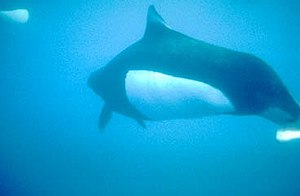White-flanked porpoise
| White-flanked porpoise | ||||||||||||
|---|---|---|---|---|---|---|---|---|---|---|---|---|

White-flanked porpoise |
||||||||||||
| Systematics | ||||||||||||
|
||||||||||||
| Scientific name of the genus | ||||||||||||
| Phocoenoides | ||||||||||||
| Andrews , 1911 | ||||||||||||
| Scientific name of the species | ||||||||||||
| Phocoenoides dalli | ||||||||||||
| ( True , 1885) |
The white-flanked porpoise ( Phocoenoides dalli ) or Dall harbor porpoise (named after William Healey Dall ) is a species of whale from the porpoise family (Phocoenidae). The species hit the headlines in the 1970s when it was first discovered that thousands of animals die annually from being caught in the nets and drowning while fishing for salmon .
distribution
White-flanked porpoises are found in the northern Pacific and Bering Sea . In the south their distribution area extends in the east to the Baja California peninsula , in the west to southern Japan . Migrations are known, in summer they stay in more northerly areas, while in winter they migrate southwards.
description
When fully grown, the harbor porpoise is between 1.9 and 2.4 meters long and weighs between 170 and 210 kilograms. This makes it the heaviest harbor porpoise.
The white-flanked porpoise owes its name to a white flank that extends from the belly to the dorsal fin , while the top is black. The tip of the fin is also colored white. The coloring of the animals is similar to that of the killer whale .
Way of life
With a top speed of up to 55 km / h, they are among the fastest swimmers of all whales. They move in a zigzag pattern. They live in small schools of two to ten animals, but several hundred of these animals can gather in rich food grounds. Their diet consists mainly of squid and fish . Since deep-sea species have also been found in their stomachs, it is believed that they are good divers. This whale species is around 15 years old.
hybrid
In 1998, a fetus of a whale was found in British Columbia ( Canada ), which DNA tests showed to be a hybrid between a white-flanked porpoise and a common porpoise . Such hybrids may be more common, which would explain a number of atypically colored specimens that have been spotted near Vancouver Island .
threat
The greatest threat to this species of whale is whaling , which has been increasing since the mid-1980s, when the whaling moratorium for many large whale species came into force. 1988 brought the climax with 45,000 animals killed, the current annual catch quota is 18,000 animals. Since whaling is almost exclusively carried out from Japan , the animals of the western Pacific are particularly threatened. Also, many animals still die as bycatch in the fishing nets, the extent to which this factor affects the overall population is not exactly known.
supporting documents
literature
- Richard Sale: A Complete Guide to Arctic Wildlife , published by Christopher Helm, London 2006, ISBN 0-7136-7039-8
Web links
- White-flanked porpoise
- Phocoenoides dalli in the endangered Red List species the IUCN 2008. Posted by: PS Hammond u. a., 2008. Retrieved January 2, 2009.
Single receipts
- ^ Sale, p. 435

